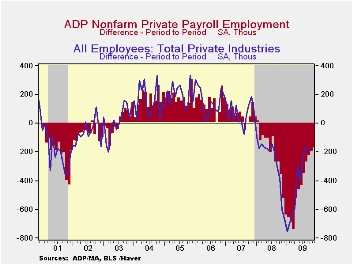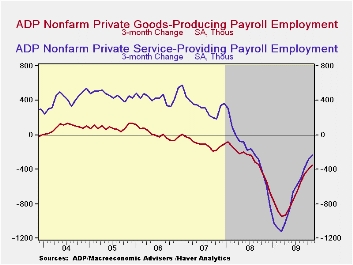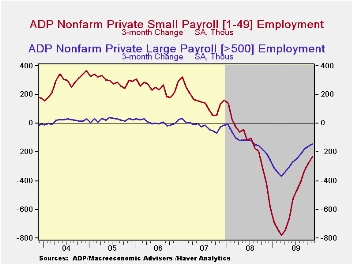 Global| Dec 01 2009
Global| Dec 01 2009ADP Report: U.S. Payroll Employment Decline Moderates Further
by:Tom Moeller
|in:Economy in Brief
Summary
Payroll employment fell again last month, but the rate of decline slowed further. The latest report from the payroll processor ADP, in their National Employment Report, indicated that private nonfarm payrolls fell 169,000 during [...]
 Payroll
employment fell again last month, but the rate of decline slowed
further. The latest report from the payroll processor ADP, in their
National Employment Report, indicated that private nonfarm payrolls
fell 169,000 during November. That followed a revised 195,000 October
decline which was shallower than reported initially. The latest reading
was the twenty-second consecutive monthly decline. The monthly drop,
however, was the smallest decline since July of last year and
three-quarters the size of the worst reading last March. The
three-month annualized rate of decline in payrolls also eased to 2.1%
from its March record of 7.1%.
Payroll
employment fell again last month, but the rate of decline slowed
further. The latest report from the payroll processor ADP, in their
National Employment Report, indicated that private nonfarm payrolls
fell 169,000 during November. That followed a revised 195,000 October
decline which was shallower than reported initially. The latest reading
was the twenty-second consecutive monthly decline. The monthly drop,
however, was the smallest decline since July of last year and
three-quarters the size of the worst reading last March. The
three-month annualized rate of decline in payrolls also eased to 2.1%
from its March record of 7.1%.
 ADP
compiled the estimate from its database of individual companies'
payroll information. Macroeconomic Advisers, LLC, the St. Louis
economic consulting firm, developed the methodology for transforming
the raw data into an economic indicator.
ADP
compiled the estimate from its database of individual companies'
payroll information. Macroeconomic Advisers, LLC, the St. Louis
economic consulting firm, developed the methodology for transforming
the raw data into an economic indicator.
The U.S. Bureau of Labor Statistics will report November payroll employment this Friday. For comparison, the October decline of 195,000 in ADP's measure of private nonfarm payrolls was accompanied by a loss of 190,000 jobs in the BLS measure of private sector payrolls.
According to ADP and Macro-Advisers, the correlation between the monthly percentage change in the ADP estimate and that in the BLS data is 0.90.
ADP reported that the decline in small-sized payrolls moderated to 68,000 (-4.1% y/y). Medium-sized payrolls fell 57,000 (-5.1% y/y) and large payrolls fell by 44,000 (-5.3% y/y). The decline in service-producing industry employment continued. The November drop of 81,000 (-2.9% y/y) was the twenty-first consecutive monthly decline but in percentage terms the three-month rate of change moderated to -1.1%, less than three-quarters, the worst from January through March. The decline in medium-sized service payrolls amounted to 30,000 (-3.2% y/y) and small-sized payrolls declined 32,000 (-2.6% y/y). Large service producing payrolls decreased 19,000 and the y/y decline eased slightly to -3.2%.
 In the goods
producing sector employment fell 88,000 during November (-12.6% y/y)
but the October decline was revised shallower. Here, the three-month
rate of decline eased again to -7.3% versus -17.3% at its worst.
Small-sized payrolls fell 36,000 (-12.4% y/y) followed by a 27,000
(-12.6% y/y) drop in medium-sized payrolls. Large payrolls fell 25,000
(-13.0% y/y). In the manufacturing sector alone, payrolls fell 44,000
(-11.8% y/y) but the three-month change moderated to -5.8% from -17.4%
at its worst.
In the goods
producing sector employment fell 88,000 during November (-12.6% y/y)
but the October decline was revised shallower. Here, the three-month
rate of decline eased again to -7.3% versus -17.3% at its worst.
Small-sized payrolls fell 36,000 (-12.4% y/y) followed by a 27,000
(-12.6% y/y) drop in medium-sized payrolls. Large payrolls fell 25,000
(-13.0% y/y). In the manufacturing sector alone, payrolls fell 44,000
(-11.8% y/y) but the three-month change moderated to -5.8% from -17.4%
at its worst.
The ADP National Employment Report data is maintained in Haver's
USECON database; historical figures date back to December 2000. The figures in this report cover only private sector jobs and exclude employment in the public sector, which rose an average 11,083 during the last twelve months.The full ADP National Employment Report can be found here and the ADP methodology is explained here.
The Estimated Impact of the American Recovery and Reinvestment Act on Employment and Economic Output as of September 2009 from the Congressional Budget Office can be found here.
| ADP National Employment Report | November | October | September | Y/Y | 2008 | 2007 | 2006 |
|---|---|---|---|---|---|---|---|
| Total Nonfarm Private PayrollEmployment (m/m Chg., 000s) | -169 | -195 | -220 | -4.7% | -0.5% | 1.2% | 2.0% |
| Small Payroll (1-49) | -68 | -77 | -88 | -4.1 | -0.0 | 1.6 | 2.2 |
| Medium Payroll (50-499) | -57 | -70 | -78 | -5.1 | -0.5 | 1.2 | 1.9 |
| Large Payroll (>500) | -44 | -48 | -54 | -5.3 | -1.6 | -0.1 | 0.4 |
Tom Moeller
AuthorMore in Author Profile »Prior to joining Haver Analytics in 2000, Mr. Moeller worked as the Economist at Chancellor Capital Management from 1985 to 1999. There, he developed comprehensive economic forecasts and interpreted economic data for equity and fixed income portfolio managers. Also at Chancellor, Mr. Moeller worked as an equity analyst and was responsible for researching and rating companies in the economically sensitive automobile and housing industries for investment in Chancellor’s equity portfolio. Prior to joining Chancellor, Mr. Moeller was an Economist at Citibank from 1979 to 1984. He also analyzed pricing behavior in the metals industry for the Council on Wage and Price Stability in Washington, D.C. In 1999, Mr. Moeller received the award for most accurate forecast from the Forecasters' Club of New York. From 1990 to 1992 he was President of the New York Association for Business Economists. Mr. Moeller earned an M.B.A. in Finance from Fordham University, where he graduated in 1987. He holds a Bachelor of Arts in Economics from George Washington University.






